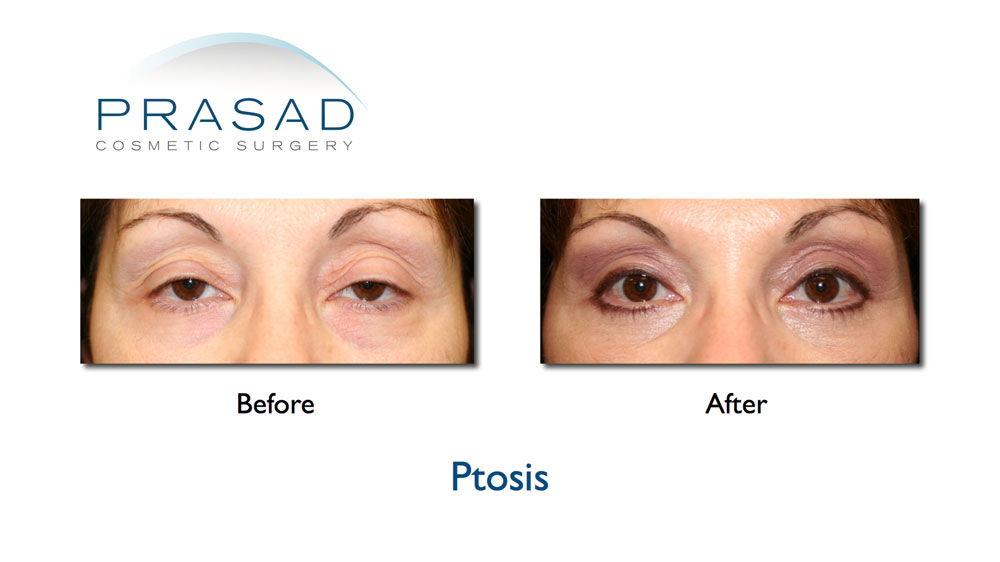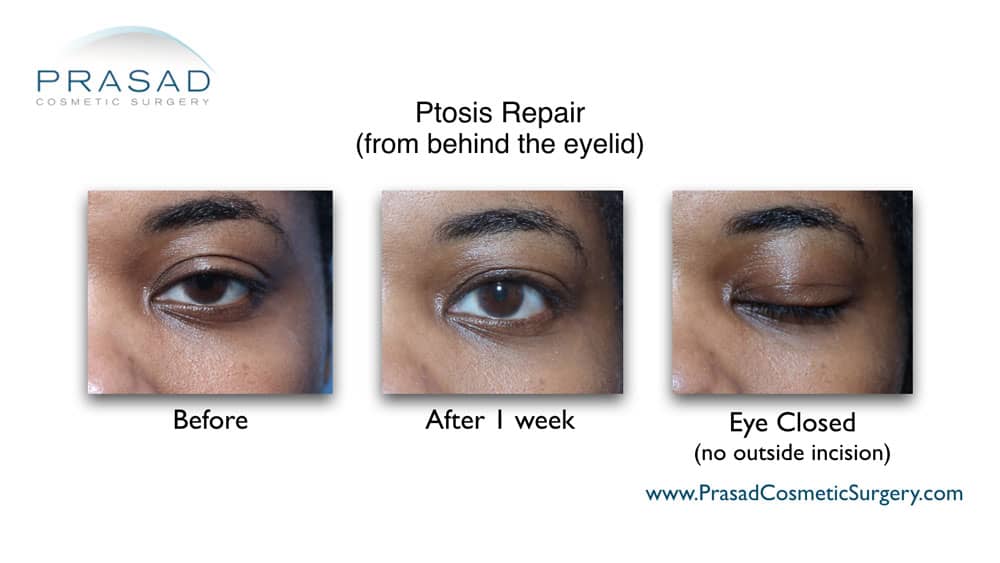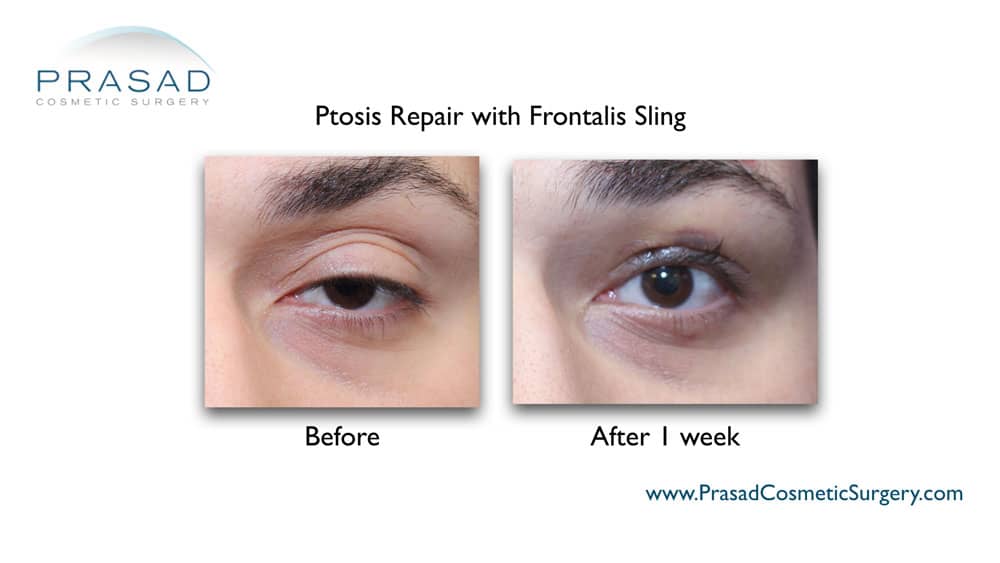What is Ptosis of the Eyelid?
Eyelid ptosis is a condition where the upper eyelid is in a lower position than it should be. Ptosis, when not associated with a neurologic condition, is usually caused by a defect of a muscle called the levator muscle which lifts the upper eyelid.
Types of Ptosis
There are 2 types of eyelid ptosis in this category: the first is congenital ptosis, which is ptosis you’re born with; the other is acquired ptosis, which is ptosis that occurs after you’re born.
In our practice, we see patients with ptosis every day. During evaluation, I’m always asked about the healing process. The healing process is very important for the outcome, as well as the ability for the patient to return to work or be seen during social events. I’ll discuss how I evaluate my patients and provide guidance about the healing process with different types of ptosis surgery I perform.
Who Performs Eyelid Ptosis Surgery?
Eyelid ptosis surgery is a specialty procedure, which is not performed by general plastic or cosmetic surgeons but rather mostly by oculoplastic or oculofacial plastic surgeons.
In fact, the presence of ptosis is often missed when cosmetic upper eyelid surgery is routinely performed for excess skin and fat. In these situations, the patients are distressed because they don’t look better after undergoing cosmetic eyelid surgery since their ptosis was not diagnosed or addressed.


The strategy for ptosis surgery is dependent on the diagnosis of the type of ptosis, the severity of the ptosis, and the relative strength or function of the levator muscle.
How to Heal Faster After Eyelid Surgery
To optimize both recovery and to maximize accuracy, I usually perform ptosis surgery with local anesthesia and LITE IV sedation. Using local anesthetic instead of general anesthesia makes recovery from surgery much faster. Patients who were put under general anesthesia often feel nausea and dizziness after surgery.
In addition, with general anesthesia, you’re recovering from the effects of general anesthesia as well as from the surgery itself. With local anesthesia and LITE sedation, our patients recover from anesthesia soon after surgery, and feel fine.
The aftercare process is important for optimizing recovery after surgery. Unless otherwise instructed, I have patients apply cold compresses to minimize swelling for the first 48 hours after surgery. Antibiotic ointment is applied to the sutures, and used only for the first two days to avoid allergic reactions, or contact dermatitis from prolonged use.

How Dr. Prasad Treats Mild Acquired Ptosis
A common form of ptosis we treat is acquired ptosis related to aging, wearing of contact lenses, eye rubbing, and allergies. Generally, this type of ptosis is mild with good levator muscle function. In this situation, I often perform ptosis surgery by shortening a muscle called Mueller’s muscle from the underside of the upper eyelid.
If there isn’t extra skin to remove in the front of the eyelid, then there is no visible sign of undergoing surgery. The recovery from this type of ptosis surgery is generally the quickest. For example, I performed this procedure for a doctor who went back to work in 2 days. I do advise my patients to take a few days off to allow for the healing process, and dissolving of internal sutures.
I often use this technique for people who’ve had cosmetic eyelid surgery done elsewhere and learn after examination that they also have ptosis. By performing the surgery from the inside of the eyelid, these patients feel better about having the surgery performed without having any new incisions and sutures on the outside.
Ptosis surgery for situations where the eyelid level is blocking the pupil or center of the eye but with good levator muscle function, is often approached by performing surgery directly on the levator muscle. At the same time, I often perform a cosmetic blepharoplasty to address excess skin and fat to get the best result. This approach is often used for age-related acquired ptosis, as well as congenital ptosis.
Healing After Mild Acquired Ptosis Surgery
The recovery is comparable to upper eyelid blepharoplasty, where sutures are removed in about 1 week after surgery and some swelling is present and diminishes over the next few weeks to months.
Ptosis Correction for More Severe Cases
A less common situation is when the levator muscle has poor to no function with the eyelid level blocking the pupil. In these situations, I perform a procedure called a frontalis sling. This is a surgery where a connection is made between the eyelid and the muscle, which lifts the eyebrows called the frontalis muscle. I place a material such as silicone, GoreTex or ePTFE as well as the patient’s own, or cadaver sourced tissue from the leg called the fascia lata.
Generally, recovery is about one week with some degree of swelling which clears over the next few weeks.


Ptosis surgery occasionally requires revision for situations where the eyelid level may be too low, or even too high. When enhancement is appropriate, I usually wait until about 3 to 6 months after the initial surgery to allow clearance of swelling.
The longevity of the benefits of surgery depend on the type of surgery performed as well as the age and other factors which are individually relevant.
If you’re considering ptosis surgery, or you’re concerned about one or both of your upper eyelids being lower than they should be, a proper diagnosis is the first step. This first step can involve seeing a neurologist, ophthalmologist, or an oculoplastic surgeon. For the types of ptosis discussed, the healing process and functional recovery can range from days to weeks with some exceptions.
